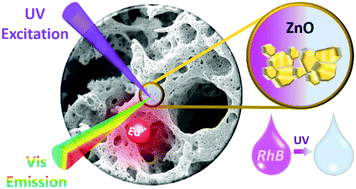Europium-doped ZnO nanosponges – controlling optical properties and photocatalytic activity†
Abstract
The optical features and photocatalytic activity of porous undoped and Eu3+-doped zinc oxide (ZnO) sponge-like structures, annealed at various temperatures, were assessed to establish the relationship between structure, morphology and photophysical properties. Upon monitoring the degradation of organic dye rhodamine B, undoped ZnO nanosponges annealed at 800 °C showed the highest photocatalytic activity, being among the best performing ZnO-based photocatalysts reported so far. The observed red- and blue-shift of the characteristic broad-band ZnO emission spectra as a function of the annealing temperature was ascribed to the nature of defects induced into the ZnO structure related to deficiency or excess of oxygen at lower (200 to 400 °C) and higher (500 to 1000 °C) annealing temperatures. These temperature-induced defects – along with the morphological sample characteristics – governed the photocatalytic performance. Doping-induced enhancement of the photocatalytic activity was noticed in specific samples and was found to markedly depend on the intrinsic properties of the undoped material. Overall, annealing temperature and europium doping concentration synergistically contributed to the defect structure, morphology and crystallinity, ultimately determining optical properties and therewith correlated photocatalytic activity.



 Please wait while we load your content...
Please wait while we load your content...